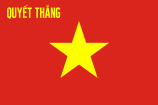
Back Vlag van Viëtnam Afrikaans የቬት ናም ሰንደቅ ዓላማ Amharic علم فيتنام Arabic علم فييتنام ARZ Vyetnam bayrağı Azerbaijani Kobér Viétnam BAN Bandera kan Bietnam BCL Сцяг В’етнама Byelorussian Сьцяг Віетнаму BE-X-OLD Национално знаме на Виетнам Bulgarian
 | |
| Cờ đỏ sao vàng ('Gold-Starred Red Flag') Cờ Tổ quốc ('Fatherland Flag') | |
| Use | Civil and state flag |
|---|---|
| Proportion | 2:3 |
| Adopted | 23 November 1940 (Cochinchina uprising) 2 September 1945 (Democratic Republic of Vietnam) 30 November 1955 (current version) 2 July 1976 (reunified Socialist Republic of Vietnam) |
| Design | A large yellow five-pointed star centered on a red field. |
| Designed by | Nguyễn Hữu Tiến (disputed) |
| Flag of the People's Army of Vietnam | |
 | |
| Use | War flag |
| Proportion | 2:3 |
| Design | A golden star centered on a red field, and yellow words Quyết thắng (Determining to win) in the upper canton. |
| Designed by | Design is a variant of the flag of Vietnam |
| Flag of the Vietnam People's Public Security | |
 | |
| Use | Police flag |
| Proportion | 2:3 |
| Design | A golden star centered on a red field, and yellow motto Bảo vệ an ninh Tổ quốc (Protecting the security of the Fatherland) in the upper canton. |
| Designed by | Design is a variant of the flag of Vietnam |
| Ensign of the Vietnam People's Navy | |
 | |
| Use | Naval ensign |
| Proportion | 2:3 |
| Adopted | 15 January 2014 |
| Design | A white flag with an emblem referring the Vietnam People's Navy in the top with the red label Hải quân Việt Nam ('Navy of Vietnam') and a blue strip below. |
| Designed by | Vietnam People's Navy, with the influence from the naval ensign of the Soviet Navy |
The national flag of Vietnam, formally the National Flag of the Socialist Republic of Vietnam (Vietnamese: Quốc kỳ nước Cộng hoà xã hội chủ nghĩa Việt Nam)[1][2] and locally recognized as the Gold-Starred Red Flag (cờ đỏ sao vàng)[a] or the Flag of Fatherland (cờ Tổ quốc), was designed in 1940 and used during an uprising against the French and Japanese in Southern Vietnam that year.[3] The red background symbolizes revolution and bloodshed. The golden star symbolizes the soul of the nation and the five points of the star represents the five main classes in Vietnamese society—intellectuals, farmers, workers, entrepreneurs, and soldiers.[4]
The initial incarnation of the flag was used by the Viet Minh, a communist-led organization created in 1941 to oppose Japanese occupation. At the end of World War II, Viet Minh leader Ho Chi Minh proclaimed Vietnam independent and signed a decree on 5 September 1945 adopting the Viet Minh flag as the flag of the Democratic Republic of Vietnam.[5] The DRV became the government of North Vietnam in 1954 following the Geneva Accords. The flag was modified on 30 November 1955 to make the points of the star straighter, which became the standard design for the Vietnamese flag until these days.[6] Until the end of the Vietnam War in 1975, South Vietnam used a yellow flag with three red stripes. The red flag of North Vietnam was later adopted as the flag of the unified Vietnam in 1976.[7] The flag of Vietnam is the only flag amongst ASEAN that does not contain the colour white, with red and yellow/gold being its historical national colours.[8]
- ^ Government of Vietnam. "About Vietnam: National flag, emblem, anthem, declaration of independence". VIETNAM GOVERNMENT PORTAL. Retrieved 3 April 2022.
- ^ "Quốc kỳ, Quốc huy, Quốc ca, Tuyên ngôn (National flag, National emblem, National anthem, Declaration (of Independence))". CỔNG THÔNG TIN ĐIỆN TỬ CHÍNH PHỦ (VIETNAM GOVERNMENT PORTAL) (in Vietnamese). Retrieved 3 April 2022.
- ^ "History of the Vietnam flag". Retrieved 10 October 2020.
- ^ "Vietnam Flag, Meaning of Vietnam Flag, History of Vietnam Flag". Archived from the original on 7 October 2013. Retrieved 5 October 2013.
- ^ "Decree number 5 of 5 September 1945" (Vitnamese)Archived 23 April 2013 at the Wayback Machine, Archive of Vietnamese legal documents.
- ^ "Resolution number 249/SL of 30 November 1955", Archive of Vietnamese legal documents.
- ^ "Resolution of 2 July 1976 (Resolution of the National Assembly of the Socialist Republic of Vietnam About the Country’s Name, Flag, Emblem, Capital, National Anthem) (Vietnamese)", Archive of Vietnamese legal documents.
- ^ "Flag of Vietnam". Encyclopedia Britannica. Retrieved 4 March 2021.
Cite error: There are <ref group=lower-alpha> tags or {{efn}} templates on this page, but the references will not show without a {{reflist|group=lower-alpha}} template or {{notelist}} template (see the help page).